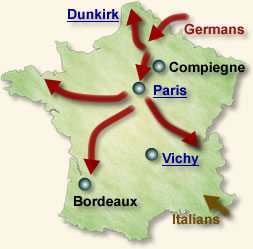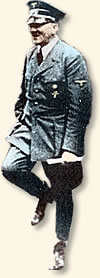|
France Surrenders, 1940
Hitler unleashes his blitzkrieg invasion of the
Low Countries and France with a fury on May 10, 1940. (see
Blitzkrieg, 1940) Within three weeks, a large part of the British force,
accompanied by some of the French defenders, is pushed to the English Channel
and compelled to abandon the continent at Dunkirk.
 |
The Fall of France, 1940
Click underlined items for
more information |
The German advance continues to sweep southward driving before it not only
the retreating French army, but an estimated 10 million refugees fleeing for
their lives. The French abandon Paris, declaring it an open city. This
allows the Germans to enter the French capital on June 14 without resistance.
The French government continues its flight southward to Bordeaux where it
disintegrates. A new government is formed with World War I hero Marshall Petain
at its head. On June 17 the aging warrior announces in a broadcast to the French
people that “It is with a heavy heart that I tell you today that we must
stop fighting.” This is the final straw that breaks the back of
the French resistance to the German invasion. The French government calls on
the Germans for an armistice that will end the fighting.
Hitler dictates that the French capitulation take place at Compiegne,
a forest north of Paris. This is the same spot where twenty-two years
earlier the Germans had signed the Armistice ending World War I. Hitler intends
to disgrace the French and avenge the German defeat. To further deepen the
humiliation, he orders that the signing ceremony take place in the same railroad
car that hosted the earlier surrender.
The Armistice is signed on June 22. Under its terms, two thirds of France
is to be occupied by the Germans. The French army is to be disbanded. In addition,
France must bear the cost of the German invasion.
William Shirer was a radio reporter for CBS News. We
join his story as he stands in a clearing in the forest of Compiegne next to
the railroad car where the ceremony will take place. Hitler and his entourage
arrive just moments before the ceremony:
"The time is now three eighteen p.m. Hitler's personal flag is run up on a small standard in the centre of the opening.
Also in the centre is a great granite block which stands some three feet above the ground. Hitler, followed by the others, walks slowly over to it, steps up, and reads the inscription engraved in great high letters on that block. It says:
| "HERE ON THE ELEVENTH OF NOVEMBER 1918 SUCCUMBED THE CRIMINAL PRIDE OF THE GERMAN EMPIRE... VANQUISHED BY THE FREE PEOPLES WHICH IT TRIED TO ENSLAVE." |
Hitler reads it and Goring reads it. They all read it, standing there in the June sun and the silence. I look for the expression on Hitler's face. I am but fifty yards from him and see him through my glasses as though he were directly in front of me. I have seen that face many times at the great moments of his life. But today! It is afire with scorn, anger, hate, revenge, triumph. He steps off the monument and contrives to make even this gesture a masterpiece of contempt. He glances back at it, contemptuous, angry - angry, you almost feel, because he cannot wipe out the awful, provoking lettering with one sweep of his high Prussian boot. He glances slowly around the clearing, and now, as his eyes meet ours, you grasp the depth of his hatred. But there is triumph there too - revengeful, triumphant hate. Suddenly, as though his face were not giving quite complete expression to his feelings, he throws his whole body into harmony with his mood. He swiftly snaps his hands on his hips, arches his shoulders, plants his feet wide apart. It is a magnificent gesture of defiance, of burning contempt for this place now and all that it has stood for in the twenty-two years since it witnessed the humbling of the German Empire.
...It is now three twenty-three p.m. and the Germans stride over to the armistice car. For a moment or two they stand in the sunlight outside the car, chatting. Then Hitler steps up into the car, followed by the others. We can see nicely through the car windows. Hitler takes the place occupied by Marshal Foch when the 1918 armistice terms were signed. The others spread themselves around him. Four chairs on the opposite side of the table from Hitler remain empty. The French have not yet appeared. But we do not wait long. Exactly at three thirty p.m. they alight from a car. They have flown up from Bordeaux to a near-by landing field. ...Then they walk down the avenue flanked by three German officers. We see them now as they come into the sunlight of the clearing.
 |
Hitler celebrates
before the ceremony | ...It is a grave hour in the life of France. The Frenchmen keep their eyes straight ahead. Their faces are solemn, drawn. They are the picture of tragic dignity. They walk stiffly to the car, where they are met by two German officers, Lieutenant-General Tippelskirch, Quartermaster General, and Colonel Thomas, chief of the Fuhrer's headquarters. The Germans salute. The French salute. The atmosphere is what Europeans call "correct." There are salutes, but no handshakes.
Now we get our picture through the dusty windows of that old wagon-lit car. Hitler and the other German leaders rise as the French enter the drawing-room. Hitler gives the Nazi salute, the arm raised. Ribbentrop and Hess do the same. I cannot see M. Noel to notice whether he salutes or not.
Hitler, as far as we can see through the windows, does not say a word to the French or to anybody else. He nods to General Keitel at his side. We see General Keitel adjusting his papers. Then he starts to read. He is reading the preamble to the German armistice terms. The French sit there with marble-like faces and listen intently. Hitler and Goring glance at the green table-top.
The reading of the preamble lasts but a few minutes. Hitler, we soon observe, has no intention of remaining very long, of listening to the reading of the armistice terms themselves. At three forty-two p.m., twelve minutes after the French arrive, we see Hitler stand up, salute stiffly, and then stride out of the drawing-room, followed by Goring, Brauchitsch, Raeder, Hess, and Ribbentrop. The French, like figures of stone, remain at the green-topped table. General Keitel remains with them. He starts to read them the detailed conditions of the armistice.
Hitler and his aides stride down the avenue towards the Alsace-Lorraine monument, where their cars are waiting. As they pass the guard of honour, the German band strikes up the two national anthems, Deutschland, Deutschland uber Alles and the Horst Wessel song. The whole ceremony in which Hitler has reached a new pinnacle in his meteoric career and Germany avenged the 1918 defeat is over in a quarter of an hour."
References:
William Shirer's account appears in: Shirer, William L., Berlin
Diary (1941); Shirer, William L., The Collapse of the Third Republic: an inquiry
into the fall of France in 1940 (1969).
How To Cite This Article:
"France Surrenders, 1940," EyeWitness to History, www.eyewitnesstohistory.com (2007).
|






